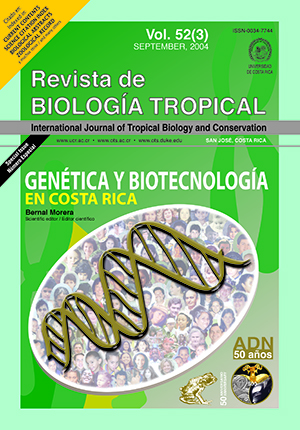Resumen
Diferentes investigaciones han demostrado que la posibilidad de llevar a cabo estudios de marcadores genéticos está muchas veces limitada por la capacidad de obtener ácidos desoxirribonucleicos (ADN) a partir de muestras degradadas como los restos óseos. Asu vez, la información que de allí se derive resulta de suma importancia en diferentes situaciones médico-legales. El presente estudio se diseñó para comparar la eficiencia de tres métodos orgánicos de extracción de ADN amplificable por la técnica de Reacción en cadena de la Polimerasa (PCR) a partir de muestras de hueso. En esta investigación se procedió a evaluar, comparativamente, la cantidad de ácidos nucleicos obtenidos, el éxito en la amplificación de marcadores microsatélites (STR) y amelogenina por PCR, la posible presencia de inhibidores y el contexto de donde provenían las muestras para los tres métodos. Una modificación del método de extracción utilizado por el FBI (Federal Bureau of Investigation) de los Estados Unidos, denominado método A, aunque no produjo la mayor cantidad de ADN, mostró el mejor rendimiento en cuanto a la calidad requerida para la amplificación por PCR. A la vez, se demostró que dicho rendimiento es influenciado por la posible presencia de inhibidores o contaminantes y por el contexto en el cual permanecieron las muestras previo a su análisis en el laboratorio. Los hallazgos sugieren que la introducción de algunas modificaciones específicas al método A (la incorporación de columnas de purificación, la cuantificación específica de ADN humano en los extractos y el uso de diluciones) podría mejorar sustancialmente el rendimiento de este método de extracción para que pueda ser utilizado con mayor éxito en diferentes investigaciones médico-legales que requieran la disponibilidad de ADN en calidad y cantidad adecuadas.Citas
Anónimo. 1994-1998. GenePrint™ STR Systems(Silver Stain Detection). Technical Manual. Promega Co. Madison, WI, USA. 52 p.
Buttler, J. 2001. Forensic DNA Typing; Biology & Technology behind STR Markers. Academic, California, USA. 322 p.
Cattaneo, C. Craig, O. James, & N. Sokol, R. 1997. Comparison of Three DNA Extraction Methods on Bone
and Blood Stains up to 43 years old and Amplification of Three Different Gene Frequencies. J. Forensic Sci. 42: 1126-1135.
Fawcett, D. 1990. Tratado de Histología. Bloom-Fawcett. México. Nueva Editorial Interamericana, S.A. 1026 p. Higuchi, R., C.H. Von Beroldingen, GF. Sensabaugh & HA. Erlich. 1988. DNA typing from single hairs. Nature 332: 543-546.
Hochmeister, M.N., B. Bodowle, U.V. Borer, O. Rudin, M. Bohnert & R. Dirnhofer. 1995. Confirmation of the identity of human skeletal remains using multiplex PCR amplification and typing kit. J. Forensic Sci. 40: 701-705.
Hochmeister, M.N., B. Budowle, UV. Borer, U. Eggman, C.E. Comey & R. Dirnhofer. 1991. Typing of deoxyrribonucleic acid (DNA) extracted from compact bone from human remains. J. Forensic Sci. 36: 1649-1661.
Jiménez-Arce, G. & B. Morera. 1999. Revisión sobre la extracción de ADN a partir de huesos humanos. Med. Legal Costa Rica 16(1/2): 11-14.
Lassen, C., S. Hummel & B. Herrman. 1996. PCR Based Sex Identification of Ancient Human Bones by Amplification of X- and Y- Chromosomal Sequences: A Comparison. Ancient Biomolecules. (Netherlands) 1(1): 25-33.
Lindahl, T. 1993. Instability and decay of the primary structure of DNA. Nature 362: 709-715.
Maniatis, T., EF. Fritsch & J. Sambrook. 1982. Molecular cloning: a laboratory manual. Cold Spring Harbor
Lab, New York, 468 p.
Matamoros, M. 1999. Frecuencias alélicas de los loci de repeticiones cortas en tandem en la población hondureña: su aplicación forense. Tesis de Maestría. Universidad de Costa Rica.
Morales C., A.I., B. Morera & G. Jiménez-Arce. 2004. La implementación forense de la tecnología del ADN en
Costa Rica: Un análisis retrospectivo. Rev. Biol. Trop. 52(3): 291-308.
Miesfeld, R. 1999. Applied Molecular Genetics. John Wiley, New York, USA. 293 p.
Morera, B. & G. Jiménez-Arce. 1998. Identificación de restos óseos mediante análisis de ADN. Med. Legal
Costa Rica 15 (1/2): 6-7.
Morera, B., R. Marín & R. Barrantes. 2001. Análisis de varios marcadores genéticos clásicos en la población de Costa Rica. Rev. Biol. Trop. 49: 1237-1252
Nakamura, Y. 1987. Variable number of tandem repeats (VNTR) markers for human gene mapping. Science
: 1616-1622.
Rojas, E. 1995. Análisis de marcadores polimórficos de ADN para pruebas de identidad. Tesis Magíster Scientiae. Universidad de Costa Rica. San José, Costa Rica.
Schultz, D.J., R. Craig, D.L. Cox-Foster, R.O. Mumma & J.I. Medford. 1994. RNA isolation from recalcitrant plant tissue. Plant Mol. Biol. Rep. 12: 310-316.
##plugins.facebook.comentarios##

Esta obra está bajo una licencia internacional Creative Commons Atribución 4.0.
Derechos de autor 2004 Revista de Biología Tropical


